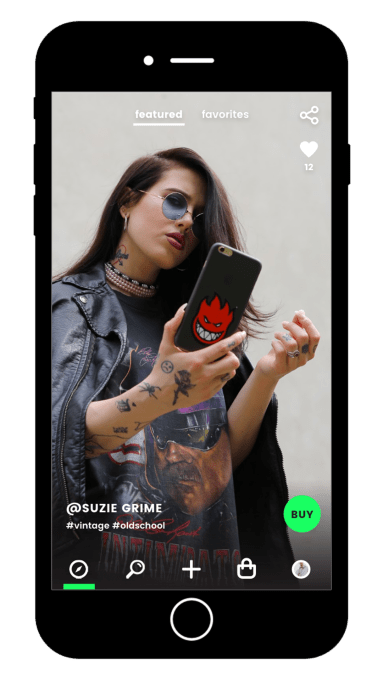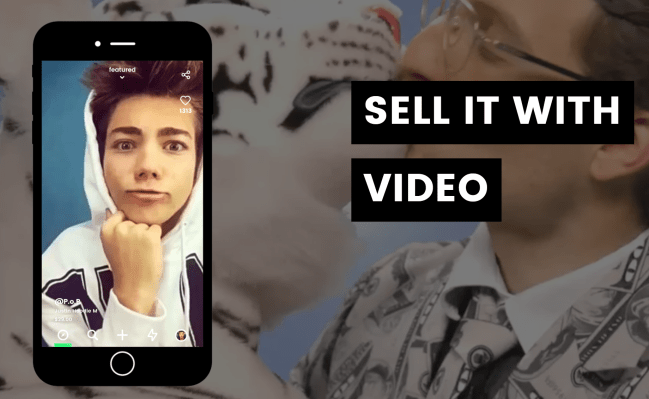Video is the name of the game in social media these days, as Facebook and Instagram continue to ramp up features to grab users from Snapchat, and Twitter moves into 24-hour news broadcasting partnerships to push more engagement. Now a startup from Berlin, Germany hopes a focus on video will help it break open a new market for e-commerce: Generation Z.
Yeay (pronounced “yay”) is a new mobile app aimed at 12-18-year-olds (or 13-18 in the case of the U.S.) that provides a platform to buy and sell things for themselves or on behalf of other brands — using short Snapchat-style video stories as its main medium, and pushing entrepreneurship by tapping into what Yeay founder Melanie Mohr sees as a key hallmark of “Gen Z” consumers: “everyone wants to be a creator.”
Yeay has been in beta since last year and now, with 500,000 downloads and 100,000 registered users, it is announcing a seed round of $4.9 million.
The funding was led by German VC Grazia Equity and Mountain Partners. Also participating were René Obermann, the former CEO of Deutsche Telekom who is now a partner at Warburg Pincus; and two veteran executives from the world of consumer goods, Elio Leoni Sceti, former CEO both of frozen food company Iglo Group and EMI Music, and Erhard Schoewel, a board member of cosmetics company Coty.
The internet is awash with ways for individuals and businesses to sell things today. They include old stalwarts like Amazon, eBay and Craigslist; a newer generation of mobile upstarts like LetGo and OfferUp; and entities like Facebook, which has woven a gigantic social web and is leveraging that to build a locally focused marketplace. The list also includes a number of steps back: see the many attempts to build social selling and purchasing platforms on top of services like Twitter and Facebook, for example.
 Yeay is among a newer wave of startups that are less interested in building direct competitors to any of these to eat into their customer bases as they are about creating new services that cater to the habits and interests of an entirely new group of consumers — similar to Snapchat, Musical.ly and Houseparty.
Yeay is among a newer wave of startups that are less interested in building direct competitors to any of these to eat into their customer bases as they are about creating new services that cater to the habits and interests of an entirely new group of consumers — similar to Snapchat, Musical.ly and Houseparty.
Notably, none of the big e-commerce platforms are known as a go-to place for 12-18-year-olds, so Yeay wants to be the eBay for this same generation.
The startup is still young and small — App Annie ranks Yeay at only 787 across all shopping apps on iOS in the U.S., and at 61 in its home market of Germany.
And there are a lot of things that it has yet to really address when you compare it to the likes of Amazon or many other smaller efforts in the area of P2P marketplaces.
For example, any and all logistics for items that are sold are left up to the seller and buyer to sort out, without Yeay providing much support (yet).
And when it comes to payments, Yeay is still trying to figure out what the best route is for its target group. Right now, it’s based around PayPal, although the idea is to explore other options.
“Gen Z does not have a sense for currencies anymore,” Mohr said, “and the world of fintech hasn’t addressed how to serve this crowd with creative tools. Most don’t have credit cards or any payment systems set up to purchase items or receive payments. Many basically use the bank of mom and dad.” She added that Yeay is looking at potentially something like a prepay system or digital currencies.
And, for now, it’s completely free to list and sell and do anything on the site: Yeay is completely pre-revenue as it builds up users and use cases.
All of what Yeay is and hopes to become as a business ultimately will have to pass regulatory muster, which in many countries may be quite stringent because the target audience is under 18. (Marketing and selling as a minor is not forbidden per se. Facebook, for example, today allows under 18s, to “purchase using the Buy button feature [but] only with the involvement of your parent or guardian.”)
If Yeay can navigate all of this, though, it could be tapping into an interesting gap in the e-commerce world.
Mohr, who is also the CEO, said that the idea for Yeay came out of two influences. The first was her observation of popular home shopping channels, which have found it hard to move to mobile and grow their audiences because many segments can last for as long as 30 minutes.
The second was her two oldest children, teenagers aged 16 and 19, who are active on Snapchat and Musical.ly. Putting two and two together, “I thought that there was an opening there, to create something like QVC or HSN, but for a younger audience,” she said. “Shorter, and more ‘Snapchatty.’ ”
Yeay takes its feature cues from these services. Users make quick videos to sell their used sneakers or clothes, and they embellish them with writing, lenses and other tweaks. They can then share and follow people on the app, or post the links elsewhere. The idea with Yeay is to make the whole sales pitch and purchase on its app, without linking users through to other websites or services to seal the deal.
Users are today posting videos of their own things for sale — some $2 million in merchandise is up for sale on Yeay right now, Mohr said — but this is only one way that the app is being used. The other is as a channel for viral marketing, using Yeay’s army of teen users’ desire to make videos and share them.
“It was a revenue stream we hadn’t thought of in the beginning, allowing people to make user-generated content for brands through brand challenges. Now we are starting to work with more brands to develop this,” Mohr said.
Yeay’s version of viral marketing has been propelled by other, much more massive video sites like YouTube. The Google-owned video platform has developed into a substantial repository of marketing videos, made by YouTube stars and those who hope to become YouTube stars, on behalf of brands as part of larger campaigns.
Search for “Pringles challenge” on YouTube and you get a long list of videos made by mostly regular people who are hoping their own versions of eating the snacks will be catchy enough to go viral to get thousands of views and followers.
Yeay’s ambition is to create a more organic kind of platform for Yeay’s users to tap into opportunities to make videos for products they like.
“Influencer marketing is broken. It worked for millennials but not Gen Z.” Yeay’s research found that some 80 percent of teenagers today do not trust brands on social media, “so it’s time for a new way. Messaging needs to come from influencers who are excited about brands and are creating content themselves, not from brands reaching out.”
Gen Z may be wary of old marketing ways, but old marketers seem to be on to them: Mohr said that multiple large agencies have been in touch, and Yeay is responding with open arms.
